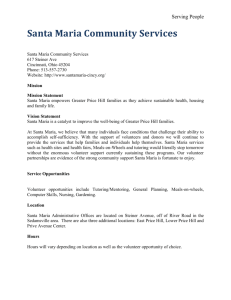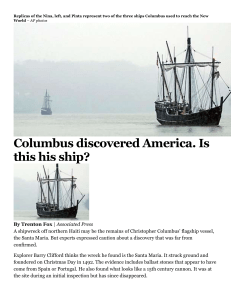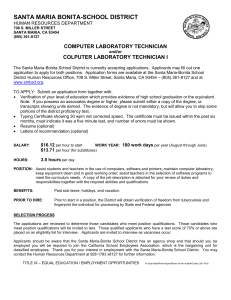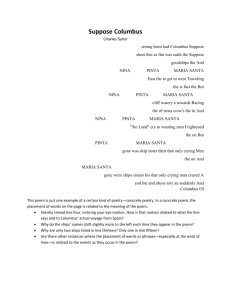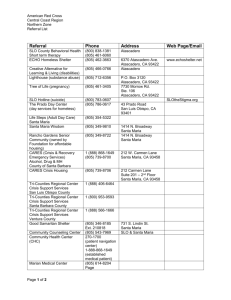SMV-Press-Kit - Santa Maria Valley Visitor Information
advertisement
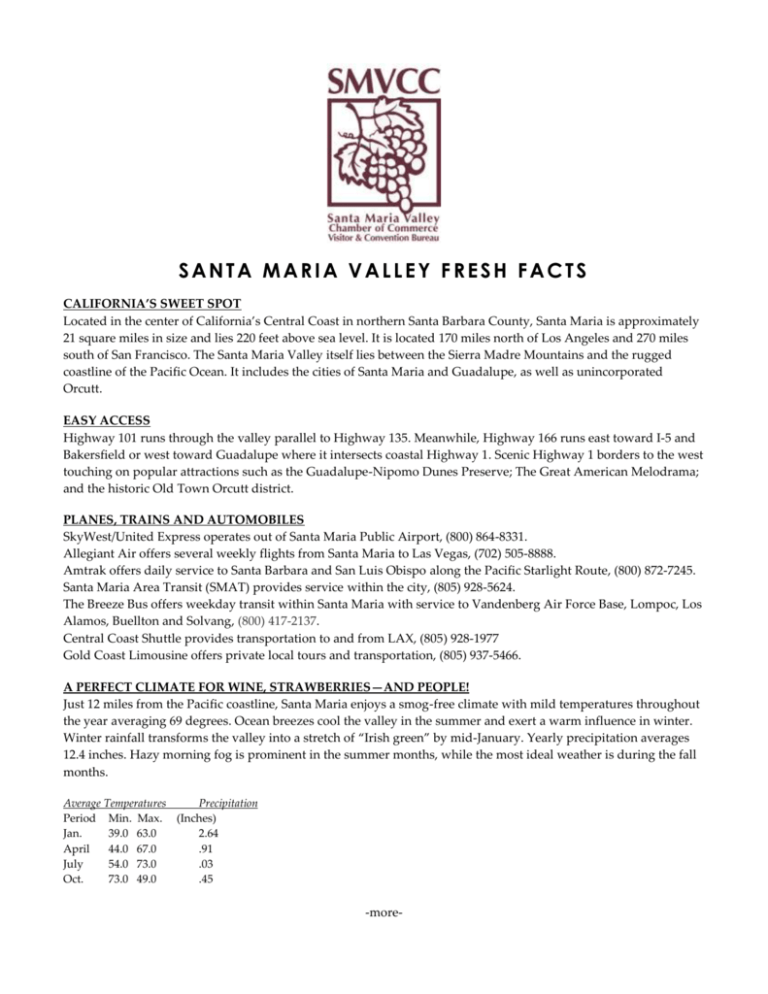
SANTA MARIA VALLEY FRESH FACTS CALIFORNIA’S SWEET SPOT Located in the center of California’s Central Coast in northern Santa Barbara County, Santa Maria is approximately 21 square miles in size and lies 220 feet above sea level. It is located 170 miles north of Los Angeles and 270 miles south of San Francisco. The Santa Maria Valley itself lies between the Sierra Madre Mountains and the rugged coastline of the Pacific Ocean. It includes the cities of Santa Maria and Guadalupe, as well as unincorporated Orcutt. EASY ACCESS Highway 101 runs through the valley parallel to Highway 135. Meanwhile, Highway 166 runs east toward I-5 and Bakersfield or west toward Guadalupe where it intersects coastal Highway 1. Scenic Highway 1 borders to the west touching on popular attractions such as the Guadalupe-Nipomo Dunes Preserve; The Great American Melodrama; and the historic Old Town Orcutt district. PLANES, TRAINS AND AUTOMOBILES SkyWest/United Express operates out of Santa Maria Public Airport, (800) 864-8331. Allegiant Air offers several weekly flights from Santa Maria to Las Vegas, (702) 505-8888. Amtrak offers daily service to Santa Barbara and San Luis Obispo along the Pacific Starlight Route, (800) 872-7245. Santa Maria Area Transit (SMAT) provides service within the city, (805) 928-5624. The Breeze Bus offers weekday transit within Santa Maria with service to Vandenberg Air Force Base, Lompoc, Los Alamos, Buellton and Solvang, (800) 417-2137. Central Coast Shuttle provides transportation to and from LAX, (805) 928-1977 Gold Coast Limousine offers private local tours and transportation, (805) 937-5466. A PERFECT CLIMATE FOR WINE, STRAWBERRIES—AND PEOPLE! Just 12 miles from the Pacific coastline, Santa Maria enjoys a smog-free climate with mild temperatures throughout the year averaging 69 degrees. Ocean breezes cool the valley in the summer and exert a warm influence in winter. Winter rainfall transforms the valley into a stretch of “Irish green” by mid-January. Yearly precipitation averages 12.4 inches. Hazy morning fog is prominent in the summer months, while the most ideal weather is during the fall months. Average Temperatures Precipitation Period Min. Max. (Inches) Jan. 39.0 63.0 2.64 April 44.0 67.0 .91 July 54.0 73.0 .03 Oct. 73.0 49.0 .45 -more- POPULATION City of Santa Maria -- 99,553 Santa Maria Valley – 135,538 City of Guadalupe – 7,080 Orcutt – 35,262 ALL-AMERICA CITY The City of Santa Maria is a regional trading, manufacturing and service center. The area’s stable economic base includes agriculture, transportation, oil, tourism, electronic manufacturing, and the government installation at nearby Vandenberg Air Force Base. With more than 6,623 people in its work force, Vandenberg is the area’s largest employer. In 1998, Santa Maria won the coveted All-America City Award from the National Civic League. The award honors community collaboration in solving problems and making the city a better place to live and work. CONTACT US Santa Maria Valley Chamber of Commerce Visitor and Convention Bureau Gina Keough, VCB Director 614 S. Broadway, Santa Maria, CA 93454 (800) 331-3779 (805) 925-2403, ext. 814 Gina@santamaria.com www.SantaMaria.com www.SantaMariaValleyBBQ.com Facebook: Visit Santa Maria Valley Twitter: Visit Santa Maria Mooncatcher Communications Christopher and Malei Weir (805) 239-0020 cw@mooncatcher.com / mw@mooncatcher.com www.Mooncatcher.com FLAVORS The Santa Maria Valley spans a unique coastal geography that boasts a spectrum of fresh and distinctive flavors. From rolling strawberry fields to magnificent vineyards, streetside barbecues to fine restaurants, the flavors of the Santa Maria Valley ultimately represent a wondrous experience for the senses. SANTA MARIA VALLEY WINE COUNTRY: Extraordinary Climate, Exquisite Grapes The Pacific fog billows inland, engulfing golden hills and inspiring a brilliant sunset. A warm afternoon yields to a cool, refreshing evening. Miles of picturesque vineyards arc into the eastern horizon. This is the scene—and the climate—that distinguishes the Santa Maria Valley wine country. The Santa Maria Valley occupies the northern perimeter of Santa Barbara County, which is today recognized as one of the world’s most dynamic winegrowing regions. The valley boasts a rare “transverse” geography, an east-west orientation that channels cool ocean air directly into the valley. The result is one of California’s longest growing seasons, which in turn ensures the development of complex, flavorful and exquisitely balanced grapes. The region’s porous, well-drained soils also contribute to exceptional fruit intensity and flavor concentration. Pinot Noir, Syrah and Chardonnay are among the varietals that excel in the Santa Maria Valley. Grapes were first planted in the area in the 1960s, but it was not until the 1970s that local wineries began to populate the valley and Santa Barbara County. Yet in just 30 years, the Santa Maria Valley and its neighboring appellations, Santa Ynez Valley and Santa Rita Hills, have grown to encompass more than 100 wineries and more than 17,000 vineyard acres. The Santa Maria Valley Wine Trail, which connects to the Foxen Canyon Wine Trail and the Santa Ynez Valley, is one of the Central Coast’s star attractions. Here, Brucher & Golden Bear Winery; Byron Vineyard; Ca’Del Grevino Vineyard; Cambria Winery & Vineyard; Costa de Oro Winery; Cottonwood Canyon Vineyard & Winery; Foxen Vineyard; Lucas & Lewellen Vineyards; Presqu'ile (press KEEL) Winery; Rancho Sisquoc Winery; Red Carpet Winery; Riverbench Vineyard; and Tres Hermanas Vineyard & Winery are among the many wineries open to visitors. Meanwhile, the annual Autumn Arts Grapes and Grains Festival, Celebration of Harvest and Santa Barbara County Vintners’ Festival all represent flavorful extravaganzas of local wine and food. The Santa Maria Valley Chamber of Commerce and Convention & Visitor Bureau offers a complimentary Tasting Brochure upon request. The guide is also available for downloading at www.santamaria.com/visit/index.html. -more- SANTA MARIA STYLE BARBECUE: The Best BBQ in The West In an age of fickle tastes and culinary fads, Santa Maria Style Barbecue continues to prove that good taste never goes out of style. The roots of Santa Maria Style Barbecue date back to the mid-1800s, when massive ranches occupied the hills of the Santa Maria Valley. Local ranchers regularly fed their crowds of ranch hands by barbecuing meat over earthen pits filled with oak wood coals. According to one source, “The Santa Maria Barbecue grew out of this tradition and achieved its ‘style’ when local residents began to string cuts of beef on skewers or rods and cook the meat over the hot coals of a red oak fire.” In 1931, the Santa Maria Club started a “Stag Barbecue,” which was held on the second Wednesday of every month, with up to 700 patrons attending each event. Over the years, the legend of Santa Maria Style Barbecue grew, turning a local treasure into a major attraction. The signature cuts for Santa Maria Style Barbecue are top block sirloin and the triangular-shaped bottom sirloin known as “tri tip,” a cut that originated in the Santa Maria Valley. The meat is rolled in a mixture of salt, pepper and garlic salt just prior to cooking. The red oak—a species of oak native to the region—contributes to a hearty, smoky flavor. Once the meat is trimmed and sliced, the only condiment needed is fresh salsa. The traditional menu also includes French bread dipped in sweet melted butter, tossed green salad and slow-cooked pinquito beans, a small pink bean that is grown exclusively in the Santa Maria Valley. Hailed by Sunset Magazine as “the west’s best barbecue town,” Santa Maria Style Barbecue is today enjoyed across the region at restaurants, events and celebrations, providing a perfect complement to the wines, strawberries and other locally grown flavors of the Santa Maria Valley. To help feed this savory phenomenon, the Santa Maria Valley Chamber of Commerce and Convention & Visitor Bureau offers its Santa Maria Style Barbecue booklet, inclusive of recipes, restaurant recommendations and more. The booklet is available for free downloading at www.santamaria.com/visit/index.html. Meanwhile, the chamber’s Official Santa Maria Style Barbecue Blog at www.santamariavalleybbq.com showcases the entire Santa Maria Style Barbecue experience. SANTA MARIA VALLEY STRAWBERRIES: A Sweet Sensation The Santa Maria Valley’s vast agricultural heritage is represented by many crops, the most colorful of which are strawberries. The region’s uniquely moderate coastal climate is a perfect match for this fragile berry, with warm winters and cool summers that support a year-round growing season. According to the most recent Santa Barbara County Crop Report, 6,657 acres of strawberries were harvested in 2012. More than 99 percent of these acres are located in the Santa Maria Valley. Total field value for local strawberries in 2012 exceeded $441 million. More than 10 strawberry varieties are grown in the valley. Santa Maria Valley strawberries are renowned for their juicy, flavorful character. While they are distributed both nationally and internationally, there is nothing like enjoying them fresh out of the field at local groceries, fruit stands, restaurants and farmers’ markets. Strawberries find their ultimate showcase each April during the Santa Maria Valley Strawberry Festival at the Santa Maria Fairpark. This berry bash features strawberry varietal sampling, strawberry desserts, educational exhibits and old-fashioned carnival entertainment. Most of the Santa Maria Valley's strawberry fields are replanted every year, a costly practice that produces a higher quality fruit and larger yields. Area farmers pride themselves on developing and utilizing new technology that allows them to produce larger crops and better berries. Several Santa Maria Valley growers and coolers offer tours for group tour planners. Call the Santa Maria Valley VCB at (800) 331-3779 for a closer look at this increasingly sophisticated industry. EXPERIENCES The Santa Maria Valley’s mild climate and complex coastal ecosystem combine to offer virtually unlimited outdoor adventures, from birdwatching to beach walking, dune hopping to agriculture tours, golfing to bicycling. Following are highlights from the many experiences of the Santa Maria Valley. GUADALUPE-NIPOMO DUNES: Nature’s Singular Masterpiece The extraordinary ecology of the Santa Maria Valley is perhaps most vividly embodied in the breathtaking Guadalupe-Nipomo Dunes Complex, which spans 22,000 acres and 18 miles. One of only two remaining coastal dunes complexes in California—and by far the largest—the Guadalupe-Nipomo Dunes Complex unfolds with awe-inspiring mountains of shifting sands that are teeming with biological diversity. Visitors to the dunes are encouraged to start their adventure at the Dunes Center, a tiny museum located in the hamlet of Guadalupe just off of historic Highway 1. Here, visitors can get information on self-led and guided hikes and walks, as well as educational resources, including interactive computer kiosks, dunes-related videos, artifacts and maps. The geological history of the dunes dates back more than 18,000 years, to the end of the last glacial period, as winds caused sand to accumulate in massive mounds along the coast. Chumash Indians later lived and hunted in the dunes, and their discarded seashells, called “shell middens,” can still be found today. Spanish explorer Juan Cabrillo was the first European to discover the dunes in 1542. Four-hundred years later, Hollywood discovered the dunes, too, using the area to stage many movies, including Cecil B. DeMille’s 1923 silent version of The Ten Commandments. The massive 700-foot set was later buried beneath the shifting sands. Thanks to an “archeological” excavation led by a documentary filmmaker, a newly expanded exhibition called, “The Lost City of DeMille” is a permanent fixture at the Dunes Center. The Guadalupe-Nipomo Dunes Complex has been declared a National Wildlife Refuge, ensuring long-term protection of its vast natural resources. Hiking, wildflower viewing, birdwatching, whale watching and nature photography are just a few of the activities that await visitors to this one-of-a-kind sanctuary. www.dunescenter.org. LOS FLORES RANCH: Stunning Open Space Equestrians, birders, mountain bikers and hikers are discovering Los Flores Ranch, a Santa Maria Valley park that offers 1,800 acres of open space and a range of stunning trails and vistas. Located eight miles south of Santa Maria on the east side of Highway 101 in the Solomon Hills, the park offers trails on existing dirt paths and paved roads that were originally created for oil and ranch operations. All equestrian and mountain biking routes are trail-based and low impact, and picnic areas are available to visitors. Guided hikes and special events are regularly planned and may be found at www.cityofsantamaria.org. -more- FORE! Picturesque and Affordable Play for Golfers of All Levels The golf courses of the Santa Maria Valley and adjacent areas are nearly as diverse as the local ecology, with everything from full-size public links to stunning resorts, beachfront fairways to greens with panoramic mountain views. Local rates are highly affordable by today’s standards. Add in the region’s amenable year-round weather and you have the makings of an unparalleled golfing experience. Please call the courses directly for the most current rates and information. At the heart of this experience is Rancho Maria Golf Course, an 18-hole public course nestled in the rolling foothills along scenic Highway 1 just southwest of the city of Santa Maria. This hidden gem is popular with locals, offering exceptional views and challenging hazards for golfers of all skill levels. It also boasts a full-size driving range and comfortable clubhouse. Blacklake Golf Resort, in Nipomo, is another local favorite. From pristine lakeside fairways to oak-studded doglegs, Blacklake offers a unique 27-hole championship golf experience that celebrates the rugged beauty of the Central Coast. Meanwhile, River Course at The Alisal, is a friendly par-72 course with stunning views of the Santa Ynez Valley. For yet another type of setting, the Avila Beach Golf Resort showcases beachfront views while meandering for 6,500 championship yards through the stunning foothills of San Luis Bay. Another popular spot is Monarch Dunes Golf Club in Nipomo, which was ranked third in Golf Digest’s 2008 list of America’s Best New Courses under $75. Other local courses of note include Cypress Ridge Golf Course in Arroyo Grande, a Peter Jacobson signature course with an on-site golf academy; La Purisima Golf Course in Lompoc, acclaimed by Golf Magazine as one of the top 100 public courses; Marshallia Ranch Golf Course at Vandenberg Air Force Base, the third most challenging military course in the world; Sunset Ridge Golf Center in Santa Maria, a nine-hole short course; and Pismo State Beach Golf Course, another short course that unfolds gently along the foredunes of Pismo Beach. Several Santa Maria hotels offer special golf packages to make a visitor’s Santa Maria Valley golf experience all the more convenient and affordable. BIRDING IN THE VALLEY: Soaring Sights Along the Pacific Flyway The Santa Maria Valley is located in the heart of the Pacific Flyway, the path that migrating birds follow along the Pacific coastline of the United States and Mexico. The Santa Maria Valley Christmas Bird Count regularly ranks among the top 100 birding places in the United States, but it is an excellent birding area year-round. Santa Maria’s Waller Park features a resident Ross’ Goose, a resident Cackling Goose as well as Western Bluebirds. Warblers of many types may be found in the park’s tall pine trees. Winter brings the White Crowned Sparrows to local feeders. Springtime welcomes Western Tanagers, Black Headed Grosbeaks and other seedeaters, and summer finds hooded orioles visiting hummingbird feeders (if the year-round Anna’s Hummingbirds are away). Allen’s Hummingbirds and Rufous Hummingbirds are also common around feeders. Preisker Park at the north end of town boasts Nesting Lawrence’s Goldfinches. Heading west on Main Street to the Rancho Guadalupe Park puts birders in proximity of the Santa Maria River mouth and an array of sea birds. Here, numerous scoters, terns, gulls, sandpipers and ducks are common sightings. Great Egrets and Snowy Egrets are also common year-round. According to one expert, “An energetic and persistent birder can identify more than 100 species of birds in a single day around the Santa Maria Valley.” Birds endemic to the region also include the yellow-billed magpie and the chestnut-backed chickadee. Other local vantages for excellent bird-watching include Pioneer Park, Guadalupe-Nipomo Dunes, Twitchell Reservoir, Point Sal and Oso Flaco Lake Natural Area. And the newer Los Flores Ranch located south of -more- town in the Solomon Hills offers 11 miles of trails available for sighting birds typical of coast live oak and oak savanna habitat. Spring land birds move through the oaks and narrow canyon riparian areas during migration and include flycatchers, kingbirds, grosbeaks and warblers. Several resources exist to point both experts and amateurs in the right direction for birding in the Santa Maria Valley. The Santa Maria Valley Visitor & Convention Bureau offers A Birder’s Guide to the Santa Maria Valley for $10. This comprehensive 54-page guide is written by seasoned local birder Gene Lynch, and includes reference drawings, location descriptions and directions, and a birder’s checklist with seasonal keys. Related resources can also be found online at www.lapurisimaaudubon.org as hosted by La Purisima Audubon Society. CULTURE The Santa Maria Valley may be famed for its nutrient-rich soil, but its bounty doesn’t stop there. The fresh and captivating spirit of this region is also reflected in its cultural offerings, yielding a visual and performing arts scene that thrives with a life all its own. PERFORMING ARTS: From Vaudeville Melodrama to Shakespeare First-time attendees tend to be surprised and awed at the top-level talent that takes to the stage in this Central Coast city. Indeed, high-caliber actors from the world over flock to Santa Maria’s Pacific Conservatory Theatre events each year. Nationally acclaimed, the theatre remains the only professional resident company on the Central Coast, and stages the finest classic and contemporary live theater plays. Attendees enjoy three excellent venues: The 440-seat, thrust-stage Marian Theatre and the flexible-seating, studio-style Severson Theatre, both at Santa Maria’s Allan Hancock College Performing Arts Center, and the outdoor Festival Theater in nearby Solvang. The Santa Maria Civic Theater is another outlet at which passionate, live community theater may be enjoyed yearround. The theater group is the oldest and longest-running one of its kind between Ventura and Monterey. Booing, hissing and audible laughter is welcome at The Great American Melodrama and Vaudeville Revue in Oceano. Here, sawdust-covered floors, cabaret tables and old-fashioned piano music welcome families to delightful evenings of classic comedies, melodramas and thrillers performed by seasoned actors from across the country. Stage-side dining is encouraged as the in-house pub pumps out an array of tasty victuals. LOCAL LANDMARKS: Memorable Discoveries from the Past and Present Celebrating the history of aviation on the Central Coast, the Santa Maria Museum of Flight emphasizes the region’s contribution to flight. Visitors wandering through two different hangars are treated to aircraft displays, memorabilia, models and photos that cover everything from the Wright Brothers to World War II to present day technology. Get up close with native animal, plant and geology exhibits at Santa Maria’s Natural History Museum. Here, individuals and children of all ages interact with rock and fossil exhibits, native bird displays and a genuine bat room. Meanwhile, the 13,000-square-foot Santa Maria Valley Discovery is the only hands-on children’s museum in Santa Barbara County. Kids learn about the origins of local produce, ranching life and the culture behind the famed -more- Santa Maria Style Barbecue. The museum even features a tar pits zone, a crafts “Creation Station,” “Discovery Diner,” bubble machine, plus a “Pets and Vets” station, and pirate ship experience. The Santa Maria Valley Historical Society and Museum is rich in photographs, artifacts and memorabilia of the Mission, Rancho and Pioneer periods as well as the Chumash Indian culture. The Historic Santa Maria Inn was established in 1917 and still retains its classic turn-of-the-century charm. Once a legendary hub for the Hollywood elite—Marilyn Monroe and Charlie Chaplain were among its famous guests—the Historic Santa Maria Inn remains steeped in the hospitality of a bygone era while boasting 164 guest rooms and 18 luxury suites with the latest amenities. Rolling vineyards and picturesque countryside are the setting for the San Ramon Chapel, a century-old church and cemetery where many of the area’s earliest settlers are at rest. The nearby Rancho Tinaquaic is the setting for Foxen Vineyard’s “foxen 7200” tasting room, while their other newer solar-powered tasting room is located at 7600 Foxen Canyon Road. English sea captain William Foxen purchased the Rancho Tinaquaic in 1837. He and his Spanish bride built an adobe on the property that remains today. And perhaps the crown jewel of the region’s historic structures is La Purisima Mission Historic State Park, the most fully restored of the three completely preserved missions within the California State Park system. Also boasting the most authentic looking setting of all the missions, La Purisima takes visitors back to its 1820 heyday and features livestock and plants of that period including burros, four-horn “churro” sheep, horses, longhorn cattle, goats, swine, turkeys and geese. More than 37 rooms are restored and furnished while the 900 acres showcase the property’s original aqueduct, washing pools, pond and more than 12 miles of maintained hiking trails. Knowledgeable guides and “characters of the past” dressed as padres, soldiers and American Indians are frequently present on weekends. The Santa Maria Valley Historical Railway Museum has arranged for three train cars from the Santa Maria Valley Railroad to be on permanent display at the Santa Maria Transit Center, located at the corner of South Miller and East Boone Street. Other items are on display inside the cars. This exhibit is open on the second and fourth Saturdays of the month. Special tours are available by appointment. (805) 714-4927. ART GALLERIES: Celebrating A Valley Brushed with Color Not surprisingly, the lush hues of Santa Maria Valley’s brilliant red strawberries, bold green crops and stunning skies inspire a range of artistic expression. From funky to traditional, a handful of eclectic art galleries dot the Santa Maria Valley landscape. Locals and visitors alike who want to take home a piece of original (and often affordable!) art may choose from a range of media at the Betteravia Gallery North and Betteravia Gallery South. These cooperative art galleries are located at 511 E. Lakeside Parkway in the Joseph Centeno Betteravia Government Center in Santa Maria. The galleries specialize in local artists, some of whom are nationally renowned. A satellite location of rotating exhibits also exists at the Santa Maria Public Airport. Here, travelers waiting for a flight can enjoy scenes of the Central Coast and even purchase art as a souvenir. The Betteravia Galleries are open Monday through Friday from 8 a.m. to 5 pm. Meanwhile, the Guadalupe Cultural Arts & Education Center boasts four galleries in a historic home; Allan Hancock Art Gallery, features monthly exhibits and art shows by students and nationally acclaimed artists. The Santa Maria Valley is also rich with outdoor art, inclusive of mosaics and murals. A VALLEY RICH IN HISTORY The beginnings of Santa Maria Valley’s development date back to the adventurous era of Spanish land grants and ranchos. Before then, the sprawling terrain was solely home to the sagebrush, deer, bears, rabbits and Chumash Indians who made their homes along the coastal sand dunes to escape the valley’s pollen, dust and wind. EXPLORERS BLAZE A TRAIL After Spanish explorer Juan Rodriguez Cabrillo arrived in the Valley in 1542, and the Portola exploration party passed through in 1769 during its search for the Monterey Bay, two sites were eventually chosen to the north and southwest for missions built by the Spanish church. Mission San Luis Obispo de Tolosa (1772) and La Purisima Concepcion (1787) were catalysts for early settlement, and flourished until 1821 when Spain granted Mexico independence and the missions were secularized. Lands were broken up and for the first time individuals were granted land ownership. SETTLERS CARVE OUT A CULTURE When Benjamin Foxen purchased Rancho Tinaquaic in 1837, he and his Chumash Indian bride, the former Eduarda Osuna, built a small adobe on the property. The Foxen family lived for many generations on the rancho where Benjamin was called “Don Julian” by Eduarda’s people. One of Foxen’s daughters, Ramona, married Englishman Frederick Wickenden. Their early adobe still stands. Ramona longed for a nearby church as the drive to the Santa Inez Mission proved to be quite a task with their many small children. Ultimately, the death of Benjamin Foxen inspired the construction of the San Ramon Chapel in 1875. Today, the chapel, is visible from Foxen Canyon Road, and has been dedicated as County Landmark No. 1 and as State Landmark No. 877. Santa Maria Valley’s first town was La Graciosa, which included a store, post office and school located near present-day Orcutt. However, in 1877, H.M. Newhall was granted the land on which the town was built, and summarily ejected one and all. THE CITY DECIDES ON A NAME While the nineteenth century saw California gain statehood, the Santa Maria Valley blossomed as one of the most productive agricultural regions in the state. The area’s multi-ethnic population also grew as Swiss-Italian dairymen, and Filipino, Portuguese and Japanese farmers joined the already established English, Irish and Scottish and Mexican settlers. Between 1869 and 1874, four of the Valley’s prominent settlers, Rudolph Cook, John Thornburg, Isaac Fesler and Isaac Miller, farmed the land at the corners of Broadway and Main Streets. In 1874, these individuals each donated a square-mile of land where their properties met to form a four-mile city center. The township was surveyed in the fall of 1874, and the surveyor’s maps were accepted and recorded at the county seat on April 12, 1875. -more- First christened Grangerville, and later Central City, the name was ultimately changed to “Santa Maria” on February 18, 1885 because mail was often mistakenly sent to Central City, Colorado. “Santa Maria” was the name that one of the area’s early settlers, Juan Pacifico Ontiveros, had given to his property in the 1850s. He also made it the name for a nearby creek, which is today known as the Santa Maria River. The city remained limited to four square miles until 1954. Since then, annexations have increased its size to roughly 21 square miles. “OLD MAUD” INTRODUCES NEW INDUSTRY Rich, gushing oil was discovered in the Santa Maria Valley in 1904 near what is now Orcutt. When exploratory crews struck a huge gusher, they lovingly nicknamed it “Old Maud,” and for the next 80 years, the oil industry flourished. Development intensified in the 1930s, and, by 1957, as many as 1,775 oil wells were producing $64 million worth of oil annually. Oil exploration and refining continues to be an active industry in Santa Barbara County. FLIGHT AND THE MILITARY Santa Maria was once a busy military training center. The Santa Maria Public Airport stands at the site of a U.S. Army Air Field used during World War II. The local community college is named after Capt. G. Allan Hancock, a former aviator, sea captain, oilman and explorer who founded the former Hancock College of Aeronautics where thousands of pilots trained for service during World War II. THE 21st CENTURY: A Growing City with a Hometown Outlook The City of Santa Maria takes pride in its “business friendly” reputation. In addition to the agriculture and retail mix, new industries such as aerospace, communications, high-tech research and development, energy production, military operations and manufacturing are on the rise. Santa Maria celebrated its centennial on September 12, 2005, and in 2006 the City of Santa Maria became the largest city in Santa Barbara County. While the city looks to its future, it remains proud of its past. Additional Resources on the Santa Maria Valley -City of Santa Maria, www.cityofsantamaria.org, 805-925-0951. -Santa Maria Valley Historical Society Museum, 805-922-3130. -Natural History Museum of Santa Maria, www.naturalhistorysantamaria.com, 805-614-0806. -Santa Maria Museum of Flight, www.smmof.org, 805-922-8758. -Far Western Tavern, www.farwesterntavern.com/index.html, 805-937-2211. -Hitching Post of Casmalia, www.hitchingpost1.com, 805-937-6151. -San Ramon Chapel, www.sanramonchapel.org, 805-937-4555. -Santa Maria Valley Chamber of Commerce Visitor and Convention Bureau, www.santamaria.com, 800-331-3779. Books on the Santa Maria Valley -An American Son, the story of George Aratani, founder of Mikasa and Kenwood electronics. By Naomi Hirahara -Images of America, Santa Maria Valley, by Carina Monica Montoya -Journey of Faith, by Ollie M. Kirby -Santa Maria Style Barbecue, by R.H. Tesene -The Good Years: Snippets of Santa Maria Valley History, by Shirley Contreras -This is Our Valley, by Vada F. Carlson -Santa Maria Historical Photo Album, Santa Maria Valley Historical Society -The Story of the Pioneer Picnics, by R.H. Tesene, Jim May and Pauline Lownes Novo -G. Allan Hancock, by DeWitt Meredith CURIOSITIES Fascinating facts that most locals don’t even know about! - Johnny Depp and friends enjoyed Santa Maria Style Barbecue at the Far Western Tavern while filming Pirates of the Caribbean 3 in the nearby Guadalupe Dunes. -The Legend of Zorro was based on the life of Solomon Pico, a murderous bandit who camped in the Santa Maria hills. To this day, people climb the Solomon Hills looking for treasure that Pico allegedly buried. -The Minerva Clubhouse in Santa Maria was designed by Julia Morgan, famed architect of Hearst Castle. -High School Musical and Hairspray movie star Zac Efron grew up in nearby Arroyo Grande and once starred in PCPA’s production of Peter Pan in Santa Maria. -Former Oakland Raiders coach and NFL Hall of Famer John Madden was head coach for Santa Maria’s Allan Hancock College football team in 1962 and 1963,. He was also assistant coach in 1961. He is currently the commentator for NBC’s Sunday Night Football. -The Guadalupe-Nipomo Dunes Complex boasts the highest beach dunes in the Western United States, with some towering as high as 500 feet. It is also the second largest stretch of dunes in California. -The 1923 Cecil B. DeMille silent movie, The Ten Commandments, was filmed in the Guadalupe/Nipomo Dunes Preserve. Through the decades, the massive “City of the Pharaoh” Egyptian-themed set was buried and lost beneath the sand dunes. Since then, a treasure trove of artifacts have been excavated and are on display at The Dunes Center in Guadalupe, a town just west of Santa Maria. -The Santa Maria Public Airport is near the site of the Army Air Corp Base, where more than 600 pilots were trained to fly P-38 fighter aircraft during World War II from early 1944 through the middle of 1945. -Named after G. Allan Hancock, Santa Maria’s Hancock College was the site of the Hancock College of Aeronautics—a facility that graduated more than 5,800 new pilots through their primary training phase beginning in 1939. -In 1904, Old Maud, Santa Maria’s first oil well, produced one million barrels in its first 100 days of operation. -In 1874, Santa Maria was originally named “Grangerville,” after The Grange—the first store in town. Later, the name was changed to “Central City,” due to its location between Sisquoc and Guadalupe. -more- -In 1882, the arrival of the narrow gauge Pacific Coast Railroad coincided with the city’s name change from “Central City” to “Santa Maria.” Mail meant for the township kept showing up in Central City, Colorado. -Some of Santa Barbara County’s first vineyards were planted in the Tepusquet region of Santa Maria Valley in the early 1960s. Soon after, vineyards were planted in several parts of the Santa Ynez Valley. -In 1978, the Santa Maria Valley Chamber of Commerce copyrighted the Santa Maria Style Barbecue recipe in order to protect the genuine article. -The town of Guadalupe is home to the oldest Buddhist temple in California. -Santa Maria boasts an ideal sunny, coastal climate for growing strawberries where mild winters and moderate summers produce a long growing season. All in all, Santa Maria produces 437 million pounds of strawberries annually. These are transported to markets throughout the world. -Most of Santa Maria’s strawberry fields are replanted every year. This practice is more costly, but produces higher quality fruit and higher yields. -In the early 1900s, the clams at Pismo Beach were so plentiful that farmers in the Santa Maria Valley brought truck loads home to use as crop fertilizer and feed for their hogs. -Santa Maria High School graduate Kenny Gist, Jr. (professional name Kenny O’dell) has penned numerous Nashville hits for Loretta Lynn, Tanya Tucker, The Judds and others. -The Historic Santa Maria Inn, which opened in 1917, was a favorite of William Randolph Hearst and his friends, who often stayed at the inn on their way to Hearst Castle in San Simeon. Marilyn Monroe, Shirley Temple and Rudolph Valentino were among the inn’s notable guests. The Historic Santa Maria Inn remains a favorite of celebrities when movie productions come to town. Demi Moore, Jack Lemmon, Walter Matthau are among those who have stayed in recent years. -In 1990, portions of the movie, “The Rocketeer,” were filmed at the Santa Maria Public Airport. The “Bigelow” building from the movie currently stands at the Santa Maria Museum of Flight and houses various aircraft and display cases. -The Santa Maria Valley Historical Society has within its holdings three scrapbooks created by the granddaughter of Leonard Swett, the forgotten friend and confidant of President Abraham Lincoln. The scrapbooks contain correspondence between Civil War notables and also personal artifacts. -Santa Maria Public Airport is home to several rare examples of second generation vaults used to house the Nordon Bombsight used during WWII. -Milfred Zornes is an artist whose work can be seen in the White House, the Pentagon, the Metropolitan Museum of Art and the Santa Maria Valley Historical Museum. -During World War II, half of the pilots and co-pilots who took part in the Doolittle Raid on Tokyo and at least four of the Flying Tigers graduated from flight school at Hancock College of Aeronautics of Santa Maria. -more- Famous People Who Call or Called the Santa Maria Valley “Home” Santa Maria resident AJ Tablado was a Top 12 finalist on American Idol in 2007 George Aratani, founder of Mikasa China and Kenwood Electronics, was born in Guadalupe. Mark Brunell, veteran quarterback for the NFL’s New Orleans Saints, starred at Santa Maria’s St. Joseph High School. Paul Edwards is a Grand Prix Formula Ones racecar driver and currently drives for sponsor, Red Bull. Lisa Estrada is a cheer advisor for the NBA’s Los Angeles Lakers. Blaine Johnson’s drag racing career included seven championships and 53 NHRA national event victories. His racing career ended tragically in August 1996 when he crashed at the U.S. Nationals. Gary Leffew was inducted into the Professional Rodeo Hall of Fame in 2002. Billy Simas played with the Chicago White Sox and was a relief pitcher for the Los Angeles Dodgers. Robin Ventura starred for the Los Angeles Dodgers and other teams, and also competed at the 1988 Olympics in Seoul, Korea, batting .409 for the U.S. team’s gold medal. A local ballfield is named after Ventura. Bryn Smith has played with the Orioles, the Expos, the St. Louis Cardinals, and the Colorado Rockies. Actor Terry Maratos has appeared on Sex and the City and ER. Steve Patterson played basketball for the NBA’s Portland Trailblazers. Phillip Young is a world-renown pianist. Scoop Nunes, Santa Maria’s “Mr. Baseball,” was inducted into the National Semi-Professional Baseball Congress in 1997 in Wichita, Kansas. Actress Kim Myori (Cheryl Utsunomiya) visits her family who still reside locally. Actress Jane Russell, who passed away in 2011, had moved to Santa Maria in 2003 to be near her son. In 2006, at age 84, she put together a musical show entitled "The Swinging Forties" that played twice a month at the Radisson Hotel. The show featured herself and other Santa Maria residents, including a choir director, lay preacher and retired police officer. Famed Alumni of Santa Maria’s Allan Hancock College Tim Kring, creator of the hit television show, “Heroes,” got his start editing track-and-field footage for his father, a coach at Allan Hancock College. A Santa Maria native, Tim later studied at UC Santa Barbara and USC. Brian Asselstine is a retired major league baseball player for the Atlanta Braves. NBA player Mike Bratz was with the Phoenix Suns, Cleveland Cavaliers, Golden State Warriors and Sacramento Kings. Gunther Cunningham is a former head coach of the NFL’s Kansas City Chiefs, and is now the team’s defensive coordinator Kenneth Kring was founder of the world’s leading executive search firm. He was also the 1999 national champion and U.S. record holder for the men’s Master Indoor Pentathlon. John Marshall was the assistant coach-defensive line for the NFL’s Detroit Lions and former assistant head coach/defensive coordinator for the NFL’s Carolina Panthers. Chuck Negron was the lead singer for Three Dog Night. Phillip Norwood is a Hollywood storyboard artist specializing in special effects and live-action sequences (True Lies, Terminator 2, The Abyss). Owen Siler was formerly the commandant for the U.S. Coast Guard and a member of the Joint Chiefs of Staff under Presidents Nixon, Ford and Carter. Milford Zornes is an artist whose work can be seen in the White House, the Pentagon and the Metropolitan Museum of Art. Mark Andrews received an Oscar for co-directing and co-writing Brave. -more- Jessica Chastain was nominated for a best actress Academy Award for her performance in Zero Dark Thirty, and won the Golden Globe for the same role. She was also nominated for best supporting actress for her work in The Help. Kathy Bates is an Academy Award-winning actress in television, cinema and stage for titles including Misery and Fried Green Tomatoes. Jeffrey Combs is known for his acting in Star Trek: Deep Space Nine. Boyd Gaines is a three-time Tony award-winning actor and has also performed in cinema and television. His accomplishments include The Heidi Chronicles and Cabaret. Jim Grce is a celebrated cinematographer and lighting director for such titles as The Patriot. Harry Groener is a three-time Tony-nominated stage actor for Oklahoma and Cats. Harry Hamlin is known for his acting in L.A. Law and Clash of the Titans. Mark Harelik is a respected playwright and actor for such titles as Prison Break and The Hollow Lands. Winifred Hervey is an Emmy and Golden Globe award-winning television producer and writer for such titles as The Steve Harvey Show and Golden Girls. Kathleen Lloyd Jenvay is a television and screen actress known for Magnum P.I. Lawrence Lester is a designer and producer of special effects shows in Las Vegas and beyond. Jeff McCarthy is a Broadway and movie actor whose roles have included the “Beast” in Disney’s Beauty and the Beast. Kelly McGillis is an award-winning film and stage actress known for her role in Top Gun and Witness. Ronald Omberg is a nationally recognized nuclear engineer. Leslie Parsons in an Emmy-nominated production designer and art director. Bryn Smith is a retired major league pitcher for the Colorado Rockies, Montreal Expos and St. Louis Cardinals. David Stone is a five-time Emmy-award winning instructional television producer. Cynthia Lauren Tewes is a television actress known for her role as “Julie” on The Love Boat. Robin Williams is an award-winning actor and comedian known for Good Will Hunting and Good Morning Vietnam. Pacific Conservatory of the Performing Arts (PCPA) Distinguished Alumni Zac Efron, star of High School Musical and Hairspray, and performed the voice of “Ted” in The Lorax. Kathy Bates, Academy Award-winning television, stage and screen actress (Misery; Fried Green Tomatoes; Night, Mother; Roe v. Wade; About Schmidt). Jayne Hamil, television sitcom writer/producer, The Nanny; Still Standing. April Stewart, actress and voiceover work for South Park and Winx Club. Rebecca Schweitzer, voiceover performer in CSI, Law and Order, Back to the Future and more. Jeffery Combs, stage, screen and television actor and Robie Award winner (Star Trek: Deep Space Nine). Boyd Gaines, three-time Tony award-winning stage, screen and television actor, (The Heidi Chronicles; Cabaret; Contact; Heartbreak Ridge; Evergreen). Harry Groener, three-time Tony nominated stage actor (Oklahoma; Cats; Crazy for You). Harry Hamlin, stage, screen and television actor (L.A. Law; Clash of the Titans). Mark Harelik, stage, screen and television actor and playwright (Gilmore Girls; Wings; The Hollow Lands; The Heidi Chronicles; The Immigrant). Kathleen Lloyd Jenvay, television and screen actress (Magnum, P.I.; The Missouri Breaks). Tim Kring, television executive producer and writer (Providence; Chicago Hope; Crossing Jordan) Jeff McCarthy, Broadway and movie actor (Disney’s Beauty and the Beast). Kelly McGillis, award-winning film and stage actress (Top Gun; Witness; A Seagull; Twelfth Night) -more- Cynthia Lauren Tewes, television actress (“Julie” on The Love Boat). Robin Williams, actor and comedian (Night at the Museum; A Friggin’ Christmas Miracle; Good Will Hunting; Hook; Mrs. Doubtfire; Jumanji; Good Morning, Vietnam).
